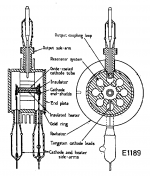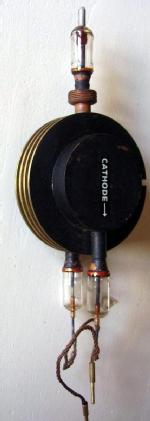|
Country:
Great Britain (UK)
|
|
| Identical to |
E1189
= NT98
= D-160052
= REL3D
= NTA98
|
| First year |
Jul.1941
-- Collector info (Sammler) 1. six cavity magnetron. Used in radar Type 271
|
| First Source
(s) |
29.Jun.1940 : -- Original-techn. papers. Megaw, 1946 IEEE article
|
| Predecessor Tubes |
E1189_Prototype
|
|
Successor Tubes
|
E1198
Q85033
706A
D-160052
1259M
|
| Was used by |
Radar |
| Filament |
Vf 6 Volts / If 1.2 Ampere / Half indirect |
| Description |
Eight segments pulsed magnetron. Typical specs: 12KW peak at 9.5cm, with 8.5KV.
Starting form the early prototype assembled by Randall and Boot at the Birmingham University, E.C.S. Megaw at GEC designed the E1189, which was the first pulsed multicavity magnetron to be produced. In the early prototypes, up to the S/N 11, the anode had six cavities, according to some tales machined using the chamber of a Colt revolver as drilling template.
The early design was modified to use an oxide coated cathode and, starting from the sample No. 12, the anode had 8 cavities.
The same sample No. 12 was brought in August 1940 to North America by the Tizard mission and its design details were disclosed to Western Electric and to Raytheon in U.S. and to R.E.L. in Canada, originating a wide variety of types.
E1189 was used in the Naval radar Type 271, operational since July 1941. The tube was standardized by the Admiralty as NT98, AP W2510.
The development of the E1189 magnetron at GEC can be read at this link.
|
| Information source |
Taschenbuch zum Röhren-Codex 1948/49
-- Original prospect or advert Callick, Metres to Microwaves
-- Original-techn. papers.
|
|
|
|
|

E1189: Manufacturer's Literature
Emilio Ciardiello
|
Collection of
|
|
|
Variants
 The decision for the new low-field eight-cavity variant was taken on 17 July 1940. Megaw launched a rush production of four samples. Two of them were sealed and serialized as E1189 No. 12 and 13. Two more samples were likely used to perform laboratory tests. The first one, assembled without the radiator and sealed with wax while continuously pumped, was likely operated on the bench since the end of July 1940, some days before the 8-slot Megaw's design was approved on 6 August 1940 and well before the No. 12 sample started its trip to America.
The decision for the new low-field eight-cavity variant was taken on 17 July 1940. Megaw launched a rush production of four samples. Two of them were sealed and serialized as E1189 No. 12 and 13. Two more samples were likely used to perform laboratory tests. The first one, assembled without the radiator and sealed with wax while continuously pumped, was likely operated on the bench since the end of July 1940, some days before the 8-slot Megaw's design was approved on 6 August 1940 and well before the No. 12 sample started its trip to America.
|
|
 The first sample made by Megaw at GEC was six-segment, machined anode block being supplied by Birmingham. Cathode was a spiral wound thoriated-tungsten filament. It started operate on 29 June 1940, giving about 1 kW pulses at 1000 Oersted magnetic field. Wavelength was about 9.8 cm. Power pulses raised to about 10 kW at 1400 Oersted in the polepieces of an electromagnet.
The first sample made by Megaw at GEC was six-segment, machined anode block being supplied by Birmingham. Cathode was a spiral wound thoriated-tungsten filament. It started operate on 29 June 1940, giving about 1 kW pulses at 1000 Oersted magnetic field. Wavelength was about 9.8 cm. Power pulses raised to about 10 kW at 1400 Oersted in the polepieces of an electromagnet.
|
|
 From No.12 E1189 was made to the new low-field eight-cavity Megaw's design. The diameter of oxide-coated cathode was increased to 6 mm. At about 1000 Oersted, in the polepieces of a 6 lbs. magnet, it was capable of delivering 5 kW minimum, 10 kW typical pulses.
S/N 12 was brought to America by the Tizard Mission and its design was unvealed to Bell, Raytheon and MIT Radiation Lab. S/N 13 was used by Megaw to characterize it.
Source: Megaw's notes
From No.12 E1189 was made to the new low-field eight-cavity Megaw's design. The diameter of oxide-coated cathode was increased to 6 mm. At about 1000 Oersted, in the polepieces of a 6 lbs. magnet, it was capable of delivering 5 kW minimum, 10 kW typical pulses.
S/N 12 was brought to America by the Tizard Mission and its design was unvealed to Bell, Raytheon and MIT Radiation Lab. S/N 13 was used by Megaw to characterize it.
Source: Megaw's notes
|
|
|
Starting from S/N 2 and up to S/N 11, E1189 was still six-cavity but cathode was half-indirect, with a 4.5 mm diameter oxide-coated nickel cylinder. E1189 S/N 2 was completed and operated at the same time of the sample S/N 1, same results. Few days after the middle of July, likely on 17, the sample No.2 went to the group of Dee at TRE.
Nine more samples were made of this variant, likely completed around the end of July and August 1940.
|
|
|
|
|
|






